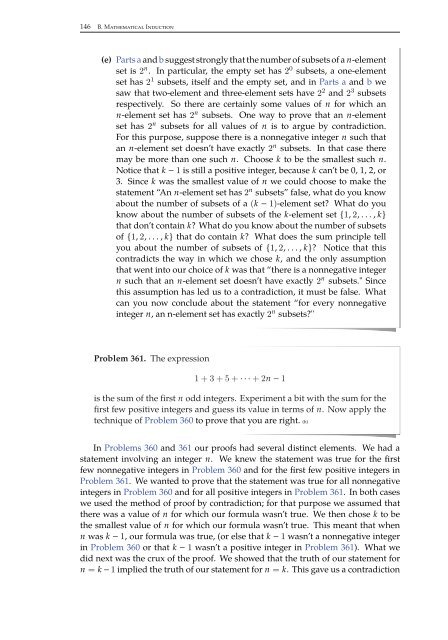Combinatorics Through Guided Discovery, 2004a
Combinatorics Through Guided Discovery, 2004a
Combinatorics Through Guided Discovery, 2004a
Create successful ePaper yourself
Turn your PDF publications into a flip-book with our unique Google optimized e-Paper software.
146 B. Mathematical Induction<br />
(e) Parts a and b suggest strongly that the number of subsets of a n-element<br />
set is 2 n . In particular, the empty set has 2 0 subsets, a one-element<br />
set has 2 1 subsets, itself and the empty set, and in Parts a and b we<br />
saw that two-element and three-element sets have 2 2 and 2 3 subsets<br />
respectively. So there are certainly some values of n for which an<br />
n-element set has 2 n subsets. One way to prove that an n-element<br />
set has 2 n subsets for all values of n is to argue by contradiction.<br />
For this purpose, suppose there is a nonnegative integer n such that<br />
an n-element set doesn’t have exactly 2 n subsets. In that case there<br />
may be more than one such n. Choose k to be the smallest such n.<br />
Notice that k − 1 is still a positive integer, because k can’t be 0, 1, 2, or<br />
3. Since k was the smallest value of n we could choose to make the<br />
statement “An n-element set has 2 n subsets” false, what do you know<br />
about the number of subsets of a (k − 1)-element set? What do you<br />
know about the number of subsets of the k-element set {1, 2,...,k}<br />
that don’t contain k? What do you know about the number of subsets<br />
of {1, 2,...,k} that do contain k? What does the sum principle tell<br />
you about the number of subsets of {1, 2,...,k}? Notice that this<br />
contradicts the way in which we chose k, and the only assumption<br />
that went into our choice of k was that “there is a nonnegative integer<br />
n such that an n-element set doesn’t have exactly 2 n subsets." Since<br />
this assumption has led us to a contradiction, it must be false. What<br />
can you now conclude about the statement “for every nonnegative<br />
integer n, an n-element set has exactly 2 n subsets?"<br />
Problem 361. The expression<br />
1+3+5+···+2n − 1<br />
is the sum of the first n odd integers. Experiment a bit with the sum for the<br />
first few positive integers and guess its value in terms of n. Now apply the<br />
technique of Problem 360 to prove that you are right. (h)<br />
In Problems 360 and 361 our proofs had several distinct elements. We had a<br />
statement involving an integer n. We knew the statement was true for the first<br />
few nonnegative integers in Problem 360 and for the first few positive integers in<br />
Problem 361. We wanted to prove that the statement was true for all nonnegative<br />
integers in Problem 360 and for all positive integers in Problem 361. In both cases<br />
we used the method of proof by contradiction; for that purpose we assumed that<br />
there was a value of n for which our formula wasn’t true. We then chose k to be<br />
the smallest value of n for which our formula wasn’t true. This meant that when<br />
n was k − 1, our formula was true, (or else that k − 1 wasn’t a nonnegative integer<br />
in Problem 360 or that k − 1 wasn’t a positive integer in Problem 361). What we<br />
did next was the crux of the proof. We showed that the truth of our statement for<br />
n = k − 1 implied the truth of our statement for n = k. This gave us a contradiction


















